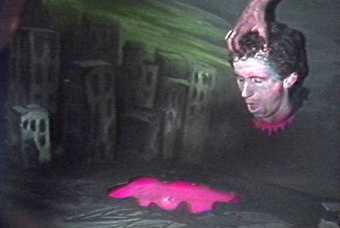As American artist Tony Ourslerās phantasmagoric projection installation The Influence Machine occupies É«æŲ“«Ć½ās River Landscape, Tate Film presents a selection of Ourslerās single-channel videos. Best known for his multimedia installations often featuring ātalkingā sculptures locked in existential quandaries, Oursler has been experimenting with video since the late 1970s, fusing strange dream landscapes and meandering psychodramatic narratives in a grotesque expressionistic theatre made entirely from recycled fragments of mediated experiences and pop-cultural tropes.
The programme follows the development of Ourslerās visual language, from his characteristically low-tech set designs, inventively assembled from brightly painted cardboard and household objects, to the use of long fixed-camera shots and claustrophobic close-ups reminiscent of his projected doll pieces.
The screening is followed by a Q&A with James Lingwood (Co-Director, ) and Iwona Blazwick (Director, ).
Tate Film is supported by Maja Hoffmann / LUMA Foundation
Grand Mal
Tony Oursler, USA 1981, colour, sound, 22 min 36
Grand Mal is a hallucinatory, discordant drama, an extravagant and sinister fable of postmodern cultural malaise. Oursler's obsessional themes and morbid visions of religion, sex and death unravel in a fragmented narrative of fear, horror, deliriumĀ ā and humour. His fantastic theatre of the absurd is propelled by a series of thematic dialectics ā heaven and hell, good and evil, life and death ā that are rendered with remarkable inventiveness and originality. The narrative's expressionistic visual dreamspace is permeated with an eerie sense of displacement and disorientation, which is echoed in Oursler's layered sound collage and somnambulant narration.
Spinout
Tony Oursler, USA 1983, colour, sound, 16 min 02
Spinout is an apocalyptic tale of a world spinning out of control to nowhere. Space travel, astrology, spirals, the universe, catastrophe and madness are recurring visual and narrative themes in this expressionistic theatre. āOf course we're all a little scared of the dark,ā says Oursler in his dreamlike narration. Rendered with his signature hand-painted sets and wildly constructed props, Spinout features a voiceover text by Oursler that is metaphorical as well as psychological, universal as well as personal.
Sucker
Tony Oursler, USA 1987, colour, sound, 5 min 33
Blood and transcendence are themes that permeate Sucker, with its incarnations of religious iconography and sexuality. Life and death, good and evil are evoked as the incantatory voiceovers and sordid images make reference to communion, transfusions, bloodbaths, bloodlust, vampires and the spectre of a virus loose in contemporary culture. Steeped in paranoia and dread, this work describes a subconscious search that is, in Oursler's words, ābased on a movie, based on a book, based on a poem, based on a myth, which is based on the quest for human immortality.ā
Model Release, Par-Schizoid-Position, and Test
Tony Oursler, USA 1992, colour, sound, 11min 44
Collaborating with writer Constance DeJong, Sonic Youth's Kim Gordon, and performance artist Karen Finley, Oursler creates a psychedelic trilogy of works exploring the theme of the destruction of the human body through violent projection, psychological as well as electronic. These sequences, in which the talking head format is superimposed on abstracted background images, can be seen to presage the tone and manner of the artist's related installations.
Model Release
1992, colour, sound, 3 min 24
āModel Release uses legal text to draw parallels between slavery, prostitution, spiritual possession and the practices of the media machine. The viewer is asked to fill-in-the-blanks of the contract and decide what part of their being they are willing to give up.ā (Tony Oursler)
Par-Schizoid-Position
1992, colour, sound, 2 min 53
āParanoid Schizoid Position uses a poetic structure to lead the viewer through the psychological evolution which ends in violent persecution of subgroups in society.ā (Tony Oursler)
Test
1992, colour, sound, 5 min 23
āTest was written in the format of the famous psychological examination MMPI (Minneapolis Personality Inventory). The viewer is invited to answer statements relating to media, violence and the body with a simple true or false response. This work is designed to evoke a moment of self reflection in the viewer.ā (Tony Oursler)
AWGTHTGTWTA
Tony Oursler, USA 2008, colour, sound, 6 min 22
AWGTHTGTWTA (Are We Going to Have to Go Through with This Again?) is one of a recent series of single-channel video works in which Oursler explores the idea of the āchorusā. Here Oursler asked high school and middle school students in Manhattan's Chelsea neighbourhood, many of whom are recent immigrants, to describe their ideal or fantasy places. The resulting piece brings together scenes of the students reciting text in unison, excerpts of their imaginative responses to Oursler's question, and found footage of the compulsive online gaming, shorthand sms text messaging, and YouTube improvisational recordings that characterize their environment. Through this combination of spoken text and frenetic gaming images, Oursler highlights disparate notions of fantasy, and gives new voice to the layered story-telling that threads through his work.

